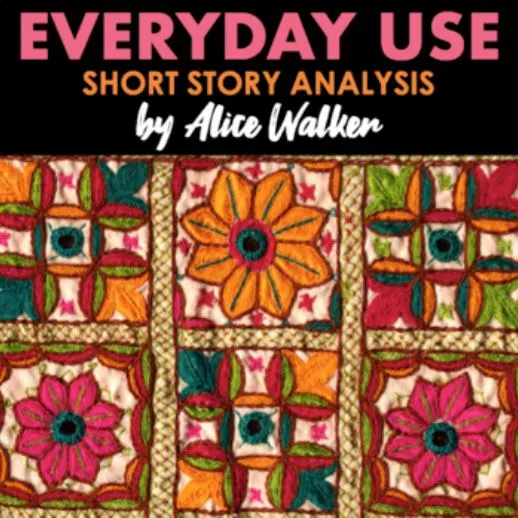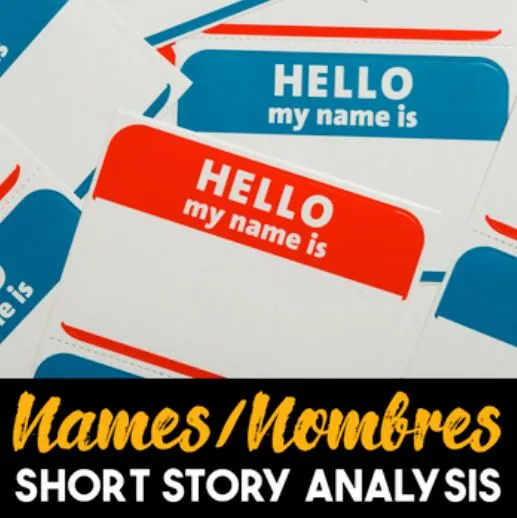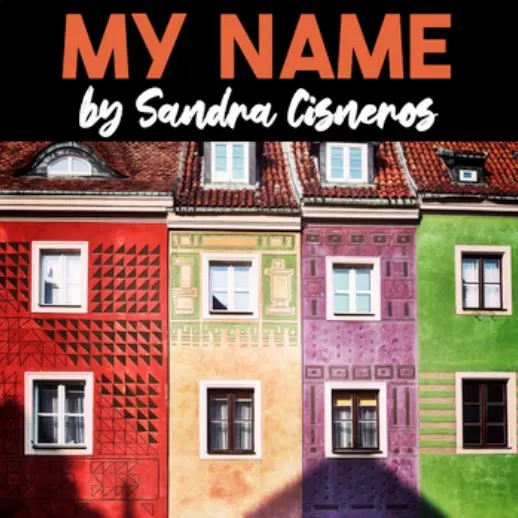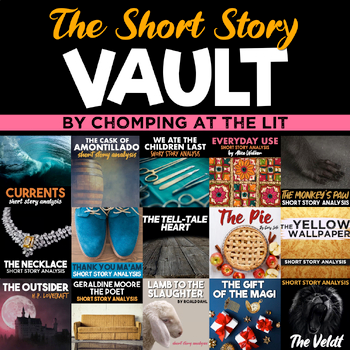Identity is an essential theme to explore in the secondary classroom. It’s the perfect theme for stimulating critical thinking as students build connections between the text and their lives. Look no further than these 15 engaging short stories perfect for teaching identity in the secondary classroom.
In a culture where we are bombarded with ideas and images of what we ‘should’ be (I’m looking at you, social media), our students face identity struggles of a whole new caliber. With the constant flow of expectations and social pressure coming from the palms of their hands, they experience a new challenge of discovering and embracing their authentic identity.
I’m pretty sure my teenage years were one giant identity crisis. (Anyone else?) I mean, what middle or high school student hasn’t struggled with identity? With trying to figure out who they are and where they belong? We’ve all been there.
From the early days of childhood, our identities are shaped by the places we go, the people we meet, and the experiences we have. Heck, the groundwork for our identity starts getting laid down before we’re even born, influenced by our parents, family, culture, and society in general.
Simply put, there are identity lessons all around us. However, it’s important to note that our students are in the throes of these defining experiences right now.
Luckily, short stories make teaching and talking about such identity lessons all the more tangible and effective.
Essential Questions for Teaching Identity
One of the best things about teaching short stories is their ability to engage students in the plot while stimulating critical thinking. Providing strong essential questions at the start of a unit or before reading a particular text will help guide students toward meaningful and insightful critical thought. These essential questions prompt students to think critically about identity by analyzing characters and making connections to themselves or society as a whole.
Here are some essential questions to stimulate students’ critical thinking as they analyze short stories and the theme of identity.
- What is identity?
- What factors define who you are?
- How much of our identity is a choice?
- What role does your identity play in how you act, speak, think, and interact with others?
- What are the implications of one’s identity in their everyday life?
- How do personal experience, stereotypes, and social norms influence our understanding of others’ identities?
- What is the author of [INSERT SHORT STORY TITLE HERE] implying about identity?
15 Engaging Short Stories for Teaching Identity
1. “Secret Samantha” by Tim Federle follows a timid 6th grader named Sam and her journey toward self-acceptance as she searches for the perfect Secret Santa gift for the new, “cool” girl at school, Blade. Ask students to consider what draws Sam to Blade and what it says about Sam’s internal struggles with identity.
2. “How to Fight Monsters” by Sherman Alexie is *technically* an excerpt from Alexie’s novel, The Absolutely True Diary of a Part-Time Indian. However, with some background info, it serves as a perfect stand-alone short story about how “unspoken rules” and expectations of a specific culture, group, or setting can impact one’s identity.
3. “Everyday Use” by Alice Walker explores internal and external conflict by analyzing how cultural, societal, and familial norms and expectations impact individual identity. Told through the eyes of Mama, an elderly black woman, the story explores the juxtaposing identities of the woman’s two daughters, Dee and Maggie, and the meaning of one’s heritage.
4. “Identities” by W.D. Valgardson follows a wealthy middle-aged man who finds himself with a desire to explore something different than his suburban life. Eventually, he finds himself lost in a rough neighborhood where he faces the consequences of assuming the identity of others,
5. “On the Sidewalk Bleeding” by Evan Huntermakes a powerful statement on internal versus external identity. As 16-year-old Andy lies on the sidewalk bleeding from a stab wound, readers learn he had joined a gang to seek approval, find meaning, and feel a sense of belonging. Unfortunately, what he once thought would give him a sense of identity is (ironically) what leads to his death.
6. “Mirror Image” by Lena Coakley takes readers on a fictional journey of the first successful brain transplant. Following a terrible accident that killed her father, protagonist Alice gets her brain transplanted into a new body. In the wake of this (somewhat creepy) scientific miracle, it takes Alice time to adjust to her new body, struggling with self-acceptance as she tries to stake a claim in her true identity.
7. “Names/Nombres” by Julia Alvarez details the challenges of her first-generation Dominican-American immigrant experience. As she describes settling into New York City, Alvarez focuses on the evolution of her name and how it seemed to define her identity and sense of belonging. By the end of the story, Alvarez makes it clear that names do not define who we are, but instead, our actions and accomplishments do.
8. “My Name” by Sandra Cisneros is a chapter excerpted from her well-known novel, The House on Mango Street. Often taught as a short story, the excerpt explores the theme of identity as the protagonist analyzes her name. As she thinks of all the ways her name defines her, both good and bad, she considers changing it altogether, wishing to transcend cultural, societal, and gender limitations.
9. “The Secret Life of Walter Mitty” by James Thurber follows an ordinary man and his extraordinary imagination as he lives two versions of his life: a mundane reality and an adventure-filled fantasy. While his overbearing wife seems to criticize his every move, Walter Mitty seems happier with the version of himself he has created in his head. Therefore, the story begs an important question—how much of our identity is influenced by the opinions of others versus our perception of self?
10. “Girl” by Jamaica Kincaid is a very short yet powerful story that follows a mother offering advice to her teenage daughter about behaving like a “proper woman.” Students will have plenty to say about gender norms, societal expectations, and the influence parents can have over their children’s identities.
11. “Recitatif” by Toni Morrison challenges readers about race and identity in a creative way. The story follows the developing friendship between two orphan girls. However, Morrison intentionally leaves the details of each girl’s race up for debate. All we know is that together, they look like “salt and pepper.” This intentional ambiguity opens the doors for discussion about race, social constructs, and identity.
12. “Fish Cheeks” by Amy Tan is a short narrative piece that analyzes Tan’s struggles with her identity as a Chinese-American teen. Tan recalls a humiliating experience when her mother invited her crush, a white boy, and his family for Christmas Eve dinner. Initially mortified by what he will think of her family’s lack of “traditional” American traditions, Tan eventually realizes how to embrace the full scope of her identity, including her Chinese heritage.
13. “The Jacket” by Gary Soto explores an age-old question about one’s identity—Do the clothes really make the man? Students can track how the young narrator’s view of his “embarrassingly ugly” jacket changes over time, reflecting his eventual self-acceptance.
14. “So What Are You Anyway?” by Lawrence Hill skillfully explores the themes of race, discrimination, and identity with one interaction between passengers on a plane. Young Carole doesn’t know anything about her racial identity until the overbearing and rude couple sitting beside her pesters her with constant questions like, “So, what are you anyway?” As the questions continue, the young girl becomes increasingly uncomfortable, highlighting her innocence and unawareness of her racial identity.
15. “Winter Dreams” by F. Scott Fitzgerald is one part love story and one part identity crisis. The story follows Dexter, a young man desperate to validate his worth through social status, financial success, and his pursuit of Judy Jones. Ironically, these very pursuits prevent him from ever finding true happiness.
Why is Teaching the Theme of Identity Important?
In a culture where we are bombarded with ideas and images of what we ‘should’ be, (I’m looking at you, social media), our students are facing identity struggles of a whole new caliber. With the constant flow of expectations and social pressure coming from the palms of their hands, they experience a new challenge of discovering and embracing their authentic identity.
Technology or not, secondary students are at a stage in their life where the theme of identity transcends any piece of literature. It’s a theme of their lives. As our students read about characters who are figuring out who they are and where they belong, they are experiencing these same challenges in their own lives.
Diving into the theme of identity with short stories provides students a safe space to unpack the various impacts on and struggles with defining one’s identity. For many students, it’s easier to talk about the identity struggles of a fictional character than it is to talk about their struggles. Therefore, teaching short stories allows our students to explore their own facets of identity while understanding how others are impacted by their words, actions, and assumptions. Exploring identity through short stories empowers students to better understand themselves, others, and the world around them.
Final Thoughts on Short Stories and Teaching Identity
Short stories have a unique way of engaging secondary students, period. However, it’s like striking gold when students can find personal connections to a short story. That’s where the theme of identity comes into play.
Whether you choose a short story or two (or three) from this post or you find your own, I encourage you to take advantage of this powerful learning opportunity. Lessons in identity teach students the power of one’s identity, where it comes from, and how it can connect us with others in literature and life.
Happy teaching!






